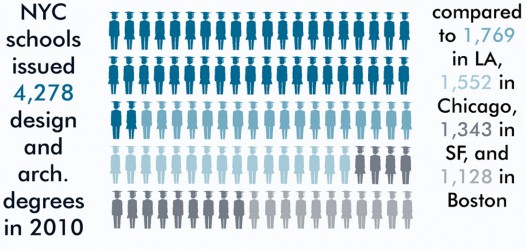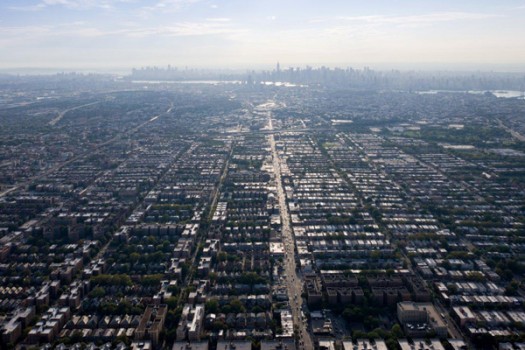
We are celebrating 15 years — and counting — of stories that are deeply researched and deeply felt, that build a historical record of what the city has been.
We are celebrating 15 years — and counting — of stories that are deeply researched and deeply felt, that build a historical record of what the city has been.
MANHATTAN MEMORIOUS
Back in 2009, Irene Cheng and Brett Snyder took us on a tour of the unbuilt city through their smartphone app of speculative proposals for New York, the Museum of the Phantom City. Recently, for the 2011 Hong Kong & Shenzhen Bi-City Biennale of Urbanism \ Architecture, Reiser + Umemoto RUR Architecture created another way to imagine the city that might have been with “Manhattan Memorious.” The short film envisions a New York in which some of the most radical proposals, both dystopian and utopian, had been built, including Buckminster Fuller’s Geodesic Dome over Manhattan, Paul Rudolph’s Lower Manhattan Expressway and adjoining housing, Rem Koolhaas’ City of the Captive Globe, RUR’s East River Corridor and Morphosis’ West Side Yards. Beginning with an interview with Robert Moses about the dire straits the city’s future is in, built into the film is the assertion that a city is not just what has been built, but also what was proposed, that a city changes gradually while the visions for its future change radically, both ends of the design spectrum leading to the city that exists.

Designing New York’s Future | a study from the Center for an Urban Future.
DESIGNING NEW YORK’S FUTURE
Last year, we spoke to David Giles from the Center for an Urban Future (CUF) when the think tank came out with Growth by Design, a study showing New York City’s deep well of design professionals and their potential contributions to the city’s future, and underlining the consistent undervaluation of the economic contributions of the field by government and the public at large. Now, CUF has followed up with Designing New York’s Future, a new study of New York City’s wealth of design education. The community of design students and institutions builds on itself, with symposia, conferences, lectures, workshops and exhibitions, creating a culture of design discourse that permeates the city. Download the study at CUF’s website, and read William Menking’s editorial about the findings in The Architect’s Newspaper.
SHELLSHOCKED
New York City’s history has been shaped by oysters. Up until the 20th century, the city was ecologically and economically dependent upon these under-appreciated bivalves. The city was known for its oysters, supporting trade and tourism, as well as filtering the water of our rivers and estuaries. But overfishing, the destruction of natural wetlands, poor water quality from sewage overflow and decades of contamination have lead to a huge drop in the oyster population. The efforts to reintroduce oysters to New York City’s waterways are proliferating (see last year’s Omnibus feature on The Oyster Restoration Project). A new documentary, SHELLSHOCKED: Saving Oysters to Save Ourselves, highlights the efforts of some scientists, government officials, artists and environmentalists to save the oyster habitats. Find more coverage at Grist.
MTA RIDERSHIP RANKINGS
The MTA has released its 2011 ridership data. Some of what the data show is common sense, major intermodal hubs have huge ridership share (Grand Central Terminal, Penn Station, 125th Street on the 4, 5 and 6, 181st Street on the 1 and A.) But some of it bears out supposition, the popularity of the overtaxed 4, 5 and 6 lines — every station between Spring Street and 96th Street falls within the top 50 stations used — shows how much the 2nd Avenue line is needed. To make browsing the information a little bit friendlier, the folks at Gothamist composed a few helpful graphs of the data they found noteworthy. Check out the full report on the MTA’s website.
NEW NYC BIKE MAP
This year’s annual NYC DOT Cycling Map was released this week, detailing bike lanes and paths throughout the city and offering information about available bike parking, bike share locations and bike shops. While bike lane construction wasn’t at its peak in 2011, 8.7 miles of lane have been added. The new map no longer splits the city into two halves and features helpful insets with closer views of highly traveled and complicated intersections as well as bridge information. Download the map from the DOT website here, and see more coverage at Streetsblog.

Jackson Heights aerial photograph, 2011 © 2011 Iwan Baan | Courtesy of the Solomon R. Guggenheim Museum
EVENTS and TO DOs
TRANSHISTORIA: In response to New York’s notoriety as “the city that never sleeps,” the Guggenheim last year launched a two-year multidisciplinary installation series that attempts to press pause on the cacophony of city life: stillspotting nyc. The third installment in the series opens this weekend in Jackson Heights, Queens, one of the city’s, as well as the country’s, most diverse neighborhoods. Transhistoria by SO-IL takes visitors on two-hour, self-guided tours of six “stillspots” in the neighborhood, where they encounter personal narratives about immigration and emigration by authors such as Roger Sedarat, René Georg Vasicek, Maria Terrone, Erik Baard, Premilla Nadasen, Nicole Steinberg, Alan Briceland and rappers such as Himanshu Suri and Ashok Kondabolu of Das Racist. The tours will run Saturdays and Sundays between April 14 and May 6, 11am–7pm with the last tour starting at 5pm. More information available here.
CITY OF DREAMS: There are two days left to submit proposals for the City of Dreams Pavilion 2012-13, a competition to design and construct an architectural pavilion on Governors Island hosted by FIGMENT, the Emerging New York Architects Committee (ENYA) of the American Institute of Architects NYC Chapter (AIANYC) and the Structural Engineers Association of New York (SEAoNY). The City of Dreams Pavilion should engage many audiences, hosting a variety of programs, and activate and energize changes in the basic practices of the architecture and design community, “where the movement toward sustainable design has only scratched the surface of what is possible and necessary.” More information available at the competition website.
FOREFRONT: This weekend, Next American City is celebrating the launch of Forefront, its new series of weekly, long-form, in-depth stories about cities, starting with Josh Stephens’ “close look at the politics that brought the agencies to their deathbed and tells the history of the controversial, if much-imitated, method of funding blight clearance and redevelopment.” For our Los Angeles readers, a launch party is taking place on Sunday, April 15, co-hosted by the California Planning & Development Report and sponsored by the American Planning Association, at WUHO Gallery. Space is limited and RSVPs are required; find more information here.
CALL FOR SUBMISSIONS: ANIMAL ARCHITECTURE AWARDS: More and more people are living in urban areas, but humans are not the only creatures that thrive in cities. Animal Architecture is calling for submissions that design with our synanthropic friends in mind, the “animals that ‘live near, and benefit from, an association with humans and the somewhat artificial habitats that humans create around them.'” Register by May 13th, with a submission deadline of June 11th. More information available here.
The Roundup keeps you up to date with topics we’ve featured and other things we think are worth knowing about.
The views expressed here are those of the authors only and do not reflect the position of The Architectural League of New York.